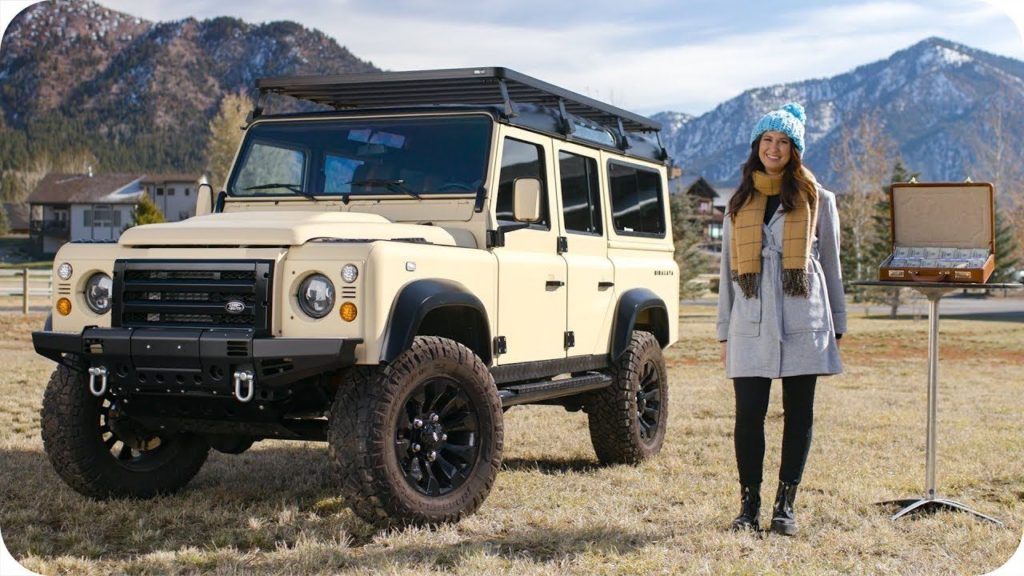Are you an adventure seeker looking to hit the open road and explore the great outdoors? If so, then you’ve come to the right place. In this article, we will delve into the world of overlanding and discover the keys to creating the perfect overlanding vehicle. Overlanding is all about self-reliance, exploration, and immersing yourself in nature. But to truly enjoy the overlanding experience, you need a vehicle that can handle rugged terrains, provide ample comfort, and house all the necessary equipment. From choosing the right vehicle to outfitting it with essential gear, we will guide you through the process step-by-step. Whether you’re a seasoned overlander looking to upgrade your rig or a newbie eager to embark on your first off-road adventure, this article will provide you with the insights and tips you need to create the perfect overlanding vehicle. So, buckle up and get ready to take your outdoor adventures to new heights!
What is Overlanding?

Overlanding is a form of self-reliant travel that involves exploring remote and undeveloped areas, usually by off-road vehicles. Unlike traditional camping or road trips, overlanding is all about the journey rather than the destination. It’s about immersing yourself in nature, experiencing different cultures, and pushing the limits of your vehicle and yourself. Overlanding allows you to venture off the beaten path, away from crowded tourist spots, and truly connect with the great outdoors.
To embark on an overlanding adventure, you’ll need a vehicle that is capable of tackling challenging terrains, carrying all your gear and supplies, and providing a comfortable living space. Whether you choose a truck, SUV, or specialized off-road vehicle, it’s important to consider the essential features that make a vehicle suitable for overlanding.
Benefits of Overlanding
Before we dive into the essential features of an overlanding vehicle, let’s explore the many benefits of overlanding. Overlanding offers a unique blend of adventure, freedom, and self-discovery. Here are a few reasons why overlanding is gaining popularity among outdoor enthusiasts:
- Exploration and Freedom: Overlanding allows you to explore remote and off-the-grid locations that are inaccessible by traditional means of transportation. It offers the freedom to go wherever your sense of adventure takes you, without the constraints of hotels or campgrounds.
- Immersing in Nature: Overlanding allows you to immerse yourself in the natural beauty of the wilderness. From breathtaking landscapes to wildlife encounters, overlanding offers an unparalleled connection with nature.
- Self-Reliance and Problem-Solving: Overlanding encourages self-reliance and problem-solving skills. It pushes you out of your comfort zone and forces you to find creative solutions to unexpected challenges that may arise on the road.
- Cultural Experiences: Overlanding often involves traveling through different countries and experiencing diverse cultures. It provides a unique opportunity to learn from locals, try new cuisines, and gain a deeper understanding of the places you visit.
Now that we’ve explored the benefits of overlanding, let’s move on to the essential features to consider when choosing a vehicle for your overlanding adventures.
Essential Features for an Overlanding Vehicle
When it comes to overlanding, your vehicle is your most important asset. It needs to be capable of handling rough terrains, carrying all your gear, and providing a comfortable living space. Here are some essential features to consider when choosing an overlanding vehicle:
- Off-Road Capability: An overlanding vehicle should have excellent off-road capabilities, including high ground clearance, four-wheel drive, and sturdy suspension. This will allow you to navigate through challenging terrains such as muddy trails, rocky roads, and river crossings.
- Cargo Space: Overlanding requires carrying a significant amount of gear and supplies. Look for a vehicle with ample cargo space, including roof racks, rear cargo areas, and built-in storage compartments. This will ensure that you have enough room for all your camping equipment, cooking utensils, clothing, and other essentials.
- Reliability and Durability: Overlanding often involves traveling long distances in remote areas, where access to repair facilities may be limited. Choose a vehicle known for its reliability and durability, with a robust engine, strong chassis, and reliable mechanical components. This will minimize the chances of breakdowns and ensure that you can continue your journey without major disruptions.
Now that you have an idea of the essential features to consider, let’s move on to the next section, where we’ll discuss how to choose the right vehicle for overlanding.
Choosing the Right Vehicle for Overlanding

Choosing the right vehicle for overlanding is a crucial decision that will greatly impact your overall experience. A vehicle like an old Defender from the 90s can be a great choice, but so can a earlies 2000s F250. Here are some factors to consider when selecting an overlanding vehicle:
- Budget: Determine your budget and stick to it. Overlanding can be an expensive endeavor, so it’s important to set realistic expectations and consider both the initial purchase cost and the long-term maintenance expenses.
- Vehicle Size: Consider the size of the vehicle based on your travel preferences and the number of people you’ll be traveling with. A larger vehicle may offer more space and comfort, but it can be more challenging to maneuver on narrow trails and tight spaces.
- Fuel Efficiency: Overlanding often involves long-distance travel, so fuel efficiency is an important factor to consider. Look for vehicles with good fuel economy to minimize your environmental impact and reduce the frequency of refueling stops.
- Resale Value: Consider the resale value of the vehicle, as overlanding preferences may change over time. A vehicle with good resale value will allow you to recoup some of your investment if you decide to sell or upgrade in the future.
Once you’ve chosen the right vehicle for your overlanding adventures, the next step is to make the necessary modifications to ensure it can handle the demands of off-road travel. Let’s explore the various vehicle modifications commonly done by overlanders.
Vehicle Modifications for Overlanding
To transform your vehicle into the perfect overlanding rig, you’ll need to make some modifications and upgrades. Here are some common modifications done by overlanders:
- Suspension Upgrades: Upgrading the suspension is essential to improve off-road performance, increase ground clearance, and enhance ride quality. This typically involves installing stronger springs, shocks, and sway bars, as well as upgrading the steering components.
- Tire Selection: Choosing the right tires is crucial for off-road adventures. Look for all-terrain or mud-terrain tires with aggressive tread patterns that provide excellent traction on different surfaces. Consider the size, load rating, and durability of the tires based on your vehicle’s specifications.
- Bull Bars and Skid Plates: Installing bull bars and skid plates will protect the front end and undercarriage of your vehicle from rocks, branches, and other obstacles. They provide added protection and peace of mind when navigating rugged terrains.
- Roof Racks and Storage Solutions: Roof racks are essential for carrying bulky items such as camping gear, kayaks, or bicycles. Invest in a sturdy roof rack system that can handle the weight and securely hold your equipment. Additionally, consider installing storage solutions inside the vehicle to maximize space and keep your belongings organized.
- Cosmetic Upgrades: Installing custom license plate frames and other items users could add to make their overlander more personalized.
Now that you’ve learned about the essential features of an overlanding vehicle and the necessary modifications, let’s move on to the next section, where we’ll discuss the packing essentials for an overlanding trip.
Packing Essentials for an Overlanding Trip
When packing for an overlanding trip, it’s important to strike a balance between bringing everything you need and keeping your vehicle’s weight within its limits. Here are some packing essentials for an overlanding trip:
- Camping Equipment: Bring a high-quality tent, sleeping bags, camping chairs, and cooking utensils. Consider portable camping stoves, coolers, and water storage solutions to ensure you have everything you need for cooking and staying comfortable during your trip.
- Safety Gear: Pack a first aid kit, fire extinguisher, and emergency signaling devices. Additionally, make sure to have a reliable GPS device or navigation system, as well as a map and compass as backup.
- Food and Water: Stock up on non-perishable food items that are easy to prepare and provide sufficient nutrition. Carry enough water for drinking, cooking, and cleaning, especially if you’re venturing into areas with limited water sources.
- Clothing and Personal Items: Pack appropriate clothing for different weather conditions, including rain gear, warm layers, and sturdy footwear. Don’t forget personal items such as toiletries, sunscreen, insect repellent, and medications.
Remember to pack efficiently, distributing the weight evenly in your vehicle to maintain stability and avoid overloading. Now that you’ve packed all the essentials, let’s move on to the next section, where we’ll discuss safety considerations for overlanding.
Safety Considerations for Overlanding
Safety should always be a top priority when embarking on an overlanding adventure. Here are some safety considerations to keep in mind:
- Vehicle Maintenance: Regularly maintain your vehicle to ensure it’s in good working condition. This includes checking the engine, brakes, fluids, and tires before each trip. Familiarize yourself with basic vehicle repairs and carry a toolkit with essential tools.
- Emergency Preparedness: Have a comprehensive emergency kit that includes items such as a spare tire, tire repair kit, jumper cables, tow straps, and a high-lift jack. Additionally, carry extra fuel, water, and food supplies in case of unforeseen circumstances.
- Communication: Invest in a reliable communication system, such as a satellite phone or two-way radios, to stay connected in remote areas with no cell phone coverage. Inform someone about your travel plans and expected return date.
- Navigation and Route Planning: Plan your routes in advance and research the areas you’ll be visiting. Familiarize yourself with the local regulations, road conditions, and potential hazards. Always have backup navigation options in case of GPS or map failures.
By following these safety considerations, you can minimize risks and ensure a safe overlanding experience. Now, let’s move on to the next section, where we’ll explore some popular overlanding routes and destinations.
Overlanding Routes and Destinations
The world is full of incredible overlanding routes and destinations, each offering unique landscapes and experiences. Here are some popular overlanding routes to consider:
- Pan-American Highway: Stretching from Alaska to Argentina, the Pan-American Highway is the ultimate overlanding adventure. It offers diverse landscapes, from snow-capped mountains to dense rainforests, and allows you to explore multiple countries and cultures along the way.
- The Silk Road: Follow the ancient Silk Road, which connected Europe and Asia, and immerse yourself in centuries-old history and diverse cultures. This overlanding route takes you through countries such as Turkey, Iran, Uzbekistan, and China.
- The Australian Outback: Explore the vast Australian Outback, with its red deserts, stunning coastlines, and unique wildlife. From the famous Gibb River Road to the iconic Great Ocean Road, Australia offers a range of overlanding experiences.
- The Trans-Siberian Highway: Embark on an epic overland journey along the Trans-Siberian Highway, which spans Russia from west to east. This route takes you through diverse landscapes, including forests, tundra, and the vast Siberian wilderness.
These are just a few examples of the countless overlanding routes and destinations around the world. Research and plan your routes based on your interests, available time, and the level of adventure you’re seeking. Now that we’ve explored popular routes and destinations, let’s move on to the next section, where we’ll discuss maintenance and care for your overlanding vehicle.
Maintenance and Care for Your Overlanding Vehicle
Proper maintenance and care are essential to keep your overlanding vehicle in top condition. Here are some tips to ensure your vehicle is always ready for your next adventure:
- Regular Inspections: Perform regular inspections of your vehicle, checking for any signs of wear and tear, leaks, or damage. Pay attention to the suspension components, brakes, fluids, and tires. Address any issues promptly to prevent further damage.
- Fluids and Filters: Regularly check and replace fluids such as engine oil, coolant, and brake fluid. Clean or replace air filters and fuel filters as needed to ensure optimal performance.
- Tire Maintenance: Monitor tire pressure regularly and adjust it based on the terrain and load. Rotate the tires regularly to ensure even wear. Check for any signs of damage or punctures and replace tires as needed.
- Cleaning and Rust Prevention: Clean your vehicle regularly, paying attention to the undercarriage and hard-to-reach areas where dirt and mud can accumulate. Apply rust prevention treatments to vulnerable areas to protect against corrosion.
By following these maintenance tips and addressing any issues promptly, you can extend the lifespan of your vehicle and enjoy worry-free overlanding adventures. Now, let’s move on to the final section, where we’ll summarize the key points discussed in this article.
Conclusion
Creating the perfect overlanding vehicle requires careful consideration of essential features, choosing the right vehicle, making necessary modifications, and packing the right gear. It’s all about finding the perfect balance between off-road capabilities, comfort, and self-sufficiency. Whether you’re embarking on a short weekend trip or a long-distance expedition, the key is to plan ahead, prepare for the unexpected, and embrace the sense of adventure that comes with overlanding. So, start your journey today, explore the world, and create unforgettable memories with your perfect overlanding vehicle. Happy travels!




